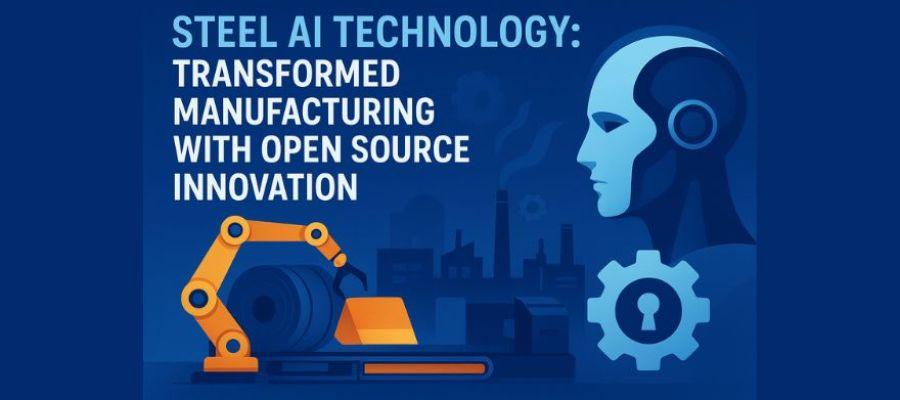Steel AI Technology, an open-source invention that boosts production speed, efficiency, and creativity, is at the centre of the manufacturing sector's dramatic transformation. Manufacturers are now pushing the envelope, cutting costs, and speeding up innovation cycles by fusing open-source collaboration with artificial intelligence (AI).
Understanding Steel AI Technology
The combination of machine learning, predictive algorithms, and AI-driven analytics with steel production processes is known as steel AI technology. Open-source AI platforms, in contrast to traditional systems, enable real-time technology contribution, sharing, and improvement by engineers, researchers, and manufacturers. This democratized strategy promotes more rapid innovation and economic scalability.
Businesses can use AI-based simulations, real-time collaboration tools, and shared code repositories to improve product design, optimise steel production, and anticipate maintenance requirements by utilising open-source frameworks.
Key Benefits of Steel AI Technology in Manufacturing
1. Enhanced Production Efficiency
AI-powered predictive analytics ensure that steel production processes run with minimal downtime. By analysing production line data, the system can forecast potential machine failures, allowing proactive maintenance.
2. Cost Reduction Through Automation
With AI-driven automation, repetitive tasks are handled with precision, freeing human operators to focus on high-value activities. This reduces operational expenses and increases ROI.
3. Accelerated Product Development
Open-source AI platforms enable rapid prototyping through digital twins virtual models that simulate real-world performance of steel products before physical production.
4. Sustainable Manufacturing
AI algorithms optimise energy consumption, reduce waste, and help companies meet environmental compliance standards while maintaining profitability.
The Role of Open Source in Steel AI Innovation
Open source plays a crucial role by eliminating proprietary barriers in steel technology development. This allows global collaboration across industries, where innovations can be adopted and customised by manufacturers worldwide.
- Shared Knowledge Base – Engineers across the globe contribute to AI models and algorithms, improving steel manufacturing efficiency collectively.
- Lower Entry Costs – Smaller manufacturers can access advanced AI tools without hefty licensing fees.
- Faster Innovation Cycle – Continuous updates and contributions from the open-source community lead to quick adoption of the latest features.
AI Applications in Steel Manufacturing
1. Predictive Maintenance
AI-powered systems monitor equipment health, detecting anomalies in real-time and scheduling repairs before breakdowns occur. This ensures maximum uptime and lower maintenance costs.
2. Quality Control & Defect Detection
Machine vision systems, trained through deep learning, can spot microscopic defects in steel sheets and components ensuring consistent product quality and reducing recalls.
3. Supply Chain Optimisation
AI-driven analytics improve demand forecasting, raw material procurement, and delivery schedules, enabling manufacturers to minimise inventory costs while meeting customer demand.
4. Process Optimisation
From temperature regulation in blast furnaces to rolling mill adjustments, AI optimises operational parameters for energy efficiency and material utilisation.
Case Study: AI-Powered Steel Production Facility
A leading global steel manufacturer implemented open-source AI tools to monitor its blast furnaces and rolling mills. The system used predictive analytics to determine optimal furnace temperature, reducing energy usage by 15%. Defect detection accuracy improved by 92%, cutting down on rework and waste. Within 12 months, the company reported a 20% increase in profitability.
Challenges and Solutions in Steel AI Technology Adoption
While the benefits are clear, integrating AI into steel manufacturing faces challenges:
- Data Privacy Concerns – Open-source tools require secure protocols to protect proprietary production data.
- Skill Gaps – AI implementation demands skilled professionals in data science and metallurgy.
- Initial Setup Costs – Upgrading infrastructure for AI readiness can be expensive.
Solutions:
- Deploy secure, hybrid AI frameworks that balance open-source collaboration with company-specific safeguards.
- Invest in AI training programs for engineers and technicians.
- Use phased implementation to spread investment over time while gradually reaping efficiency gains.
Future Trends in Steel AI Technology
1. AI-Integrated Smart Factories
Fully connected, autonomous factories will use AI to manage everything from raw material sourcing to product delivery.
2. Blockchain for Supply Chain Transparency
Coupling AI with blockchain ensures authenticity and traceability in steel manufacturing and distribution.
3. Collaborative AI Platforms
More manufacturers will contribute to shared AI libraries, creating a global network for steel innovation.
4. Green Steel Initiatives
AI will play a major role in decarbonising steel production by optimising processes that rely on renewable energy and recycled materials.
Why Steel AI Technology is the Future of Manufacturing
The fusion of AI and open-source innovation is more than just a technological trend; it’s a strategic shift toward smarter, cleaner, and more profitable manufacturing. By leveraging the collective intelligence of the global developer community, manufacturers can accelerate growth, reduce environmental impact, and maintain a competitive edge in a rapidly evolving market.
Steel AI Technology is not just revolutionising manufacturing; it is redefining the future of industry. Companies that embrace this transformation today will be the leaders of tomorrow.
